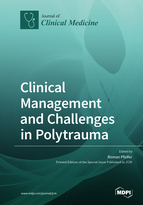Clinical Management and Challenges in Polytrauma
A special issue of Journal of Clinical Medicine (ISSN 2077-0383). This special issue belongs to the section "Emergency Medicine".
Deadline for manuscript submissions: closed (15 April 2022) | Viewed by 33391
Special Issue Editor
Special Issue Information
Dear Colleagues,
Trauma is still a leading cause of death in patients below 40 years of age. Clinical management of severely injured patients is challenging in all phases of treatment during the clinical course. Numerous factors, such as injury severity, injury pattern, patient characteristics and trauma system, affect the decision-making process in our patients. After the successful initial management of an unstable multiply injured patient, secondary definitive surgeries and reconstructions may have a risk for further systemic complications and the deterioration of the patient’s physiology. A “Safe Definitive Surgery” (SDS) concept considers the dynamics of the clinical course (preclinics, operations, complications, etc.) and the patient’s physiology. Due to the repeated re-evaluation and assessment of the patient’s clinical course, dynamics and adaptation of the treatment strategy, the safe management of polytraumatized patients is possible.
Many unanswered questions still exist and need to be addressed in future studies:
- Which patients profit by the damage control strategy and which do not?
- When is it best to start with the definitive fixation of fractures in multiply injured patients?
- How can one improve the quality of life in polytraumatized patients?
- What are the strategies in elderly severely injured patients?
With this Special Issue, we would like to stimulate research in the field of polytrauma in order to shed light on the above-mentioned questions
Dr. Roman Pfeifer
Guest Editor
Manuscript Submission Information
Manuscripts should be submitted online at www.mdpi.com by registering and logging in to this website. Once you are registered, click here to go to the submission form. Manuscripts can be submitted until the deadline. All submissions that pass pre-check are peer-reviewed. Accepted papers will be published continuously in the journal (as soon as accepted) and will be listed together on the special issue website. Research articles, review articles as well as short communications are invited. For planned papers, a title and short abstract (about 100 words) can be sent to the Editorial Office for announcement on this website.
Submitted manuscripts should not have been published previously, nor be under consideration for publication elsewhere (except conference proceedings papers). All manuscripts are thoroughly refereed through a single-blind peer-review process. A guide for authors and other relevant information for submission of manuscripts is available on the Instructions for Authors page. Journal of Clinical Medicine is an international peer-reviewed open access semimonthly journal published by MDPI.
Please visit the Instructions for Authors page before submitting a manuscript. The Article Processing Charge (APC) for publication in this open access journal is 2600 CHF (Swiss Francs). Submitted papers should be well formatted and use good English. Authors may use MDPI's English editing service prior to publication or during author revisions.
Keywords
- polytrauma
- damage control surgery
- safe definitive surgery
- quality of life
- secondary surgery
- outcome







